High Impact Tutoring Built By Math Experts
Personalized standards-aligned one-on-one math tutoring for schools and districts
In order to access this I need to be confident with:
Angles Parallel angles Perpendicular lines Solving equationsSame side interior angles
Here you will learn about same side interior angles. You’ll learn how to recognize same side interior angles, and apply this understanding to solve problems.
Students will first learn about same side interior angles as part of geometry in 8 th grade.
What are same side interior angles?
Same side interior angles, also known as consecutive interior angles or co-interior angles, are pairs of angles that are on the same side of a transversal line and inside the two lines that the transversal intersects.
The two angles that occur on the same side of the transversal are supplementary, so they always add up to 180^{\circ}.
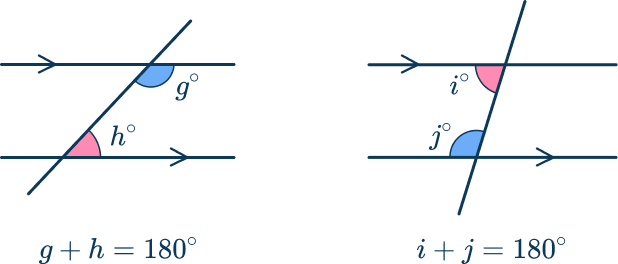
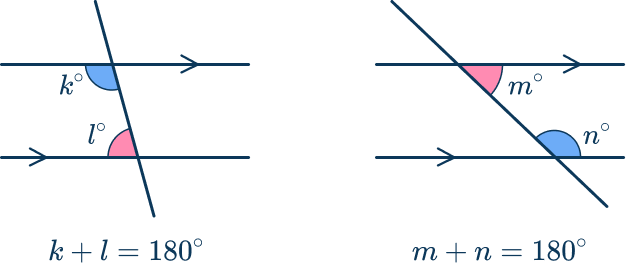
The two interior angles are only equal when they are both 90^{\circ}.
You can find the angle measure of one of the same side interior angles by subtracting the other from 180^{\circ}.
You can often spot same side interior angles by drawing a C shape.
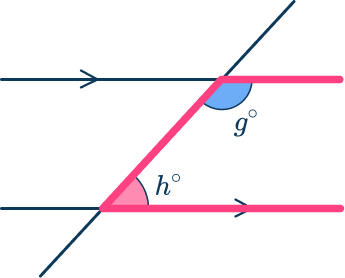
What are same side interior angles?
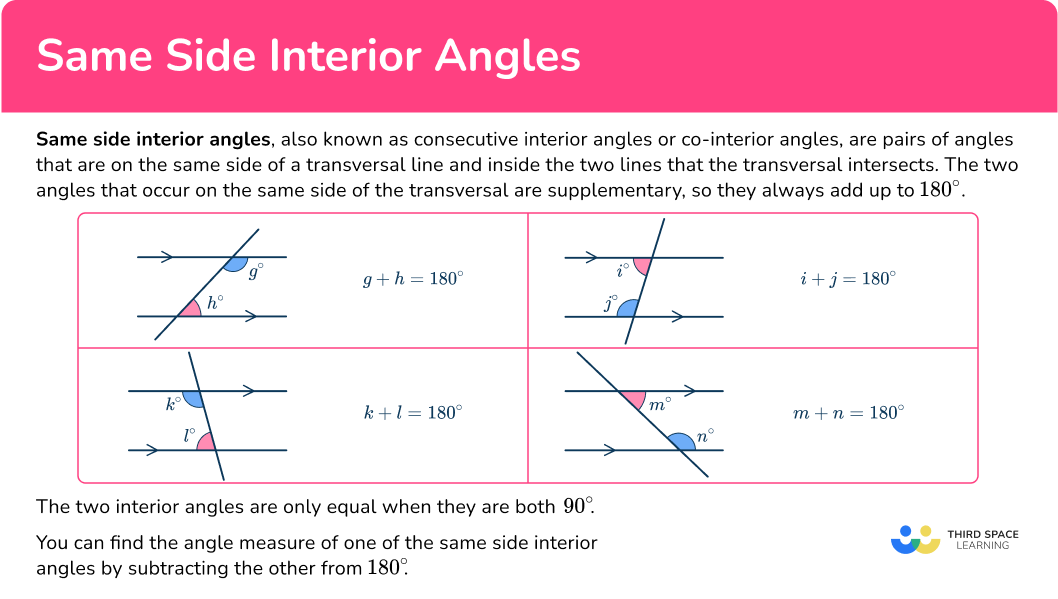
Common Core State Standards
How does this relate to 8 th grade math and high school math?
- Grade 8 – Geometry (8.G.A.5)
Use informal arguments to establish facts about the angle sum and exterior angle of triangles, about the angles created when parallel lines are cut by a transversal, and the angle-angle criterion for similarity of triangles. For example, arrange three copies of the same triangle so that the sum of the three angles appears to form a line, and give an argument in terms of transversals why this is so.
- High School – Geometry – Congruence (HS.G.CO.C.9)
Prove theorems about lines and angles. Theorems include: vertical angles are congruent; when a transversal crosses parallel lines, alternate interior angles are congruent and corresponding angles are congruent; points on a perpendicular bisector of a line segment are exactly those equidistant from the segment’s endpoints.
![[FREE] Angles Check for Understanding Quiz (Grade 4)](https://thirdspacelearning.com/wp-content/uploads/2023/08/Angles-check-for-understanding-quiz-listing-image.png)
[FREE] Angles Check for Understanding Quiz (Grade 4)
![[FREE] Angles Check for Understanding Quiz (Grade 4)](https://thirdspacelearning.com/wp-content/uploads/2023/08/Angles-check-for-understanding-quiz-listing-image.png)
Use this quiz to check your grade 4 students’ understanding of angles. 10+ questions with answers covering a range of 4th grade angles topics to identify areas of strength and support!
DOWNLOAD FREE![[FREE] Angles Check for Understanding Quiz (Grade 4)](https://thirdspacelearning.com/wp-content/uploads/2023/08/Angles-check-for-understanding-quiz-listing-image.png)
[FREE] Angles Check for Understanding Quiz (Grade 4)
![[FREE] Angles Check for Understanding Quiz (Grade 4)](https://thirdspacelearning.com/wp-content/uploads/2023/08/Angles-check-for-understanding-quiz-listing-image.png)
Use this quiz to check your grade 4 students’ understanding of angles. 10+ questions with answers covering a range of 4th grade angles topics to identify areas of strength and support!
DOWNLOAD FREEHow to calculate with same side interior angles
In order to find a missing angle in parallel lines:
- Highlight the angle(s) that you already know.
- Use same side interior angles to find a missing angle.
- Use basic angle facts if needed to calculate other missing angles.
Steps 2 and 3 may be done in either order and may need to be repeated. Step 3 may not always be required.
Same side interior angles examples
Example 1: same side interior angles
Calculate the size of the missing angle x. Justify your answer.
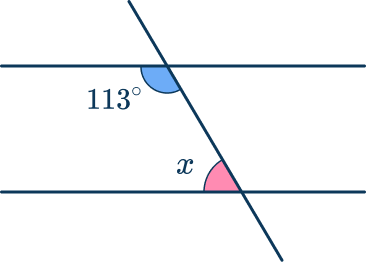
- Highlight the angle(s) that you already know.
The given angle is 113^{\circ}.
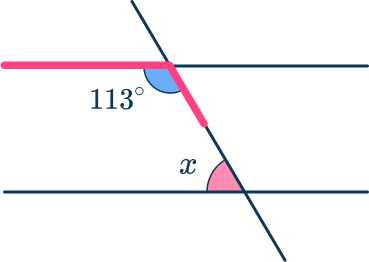
2Use same side interior angles to find a missing angle.
Here, you can label the co-interior angle on the diagram as 60^{\circ} as 113+67=180.
This gives you the measure of the missing angle:
x=67^{\circ}Example 2: same side interior angles
Calculate the size of the missing angle \theta. Justify your answer.
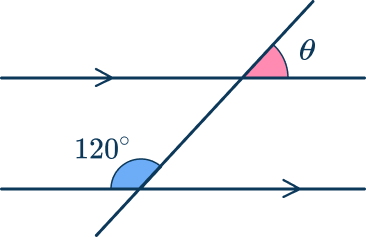
Highlight the angle(s) that you already know.
The given angle is 120^{\circ}.
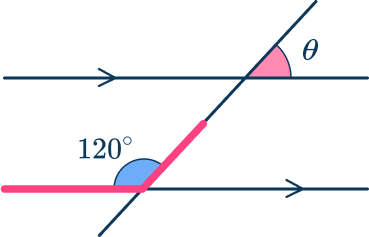
Use same side interior angles to find a missing angle.
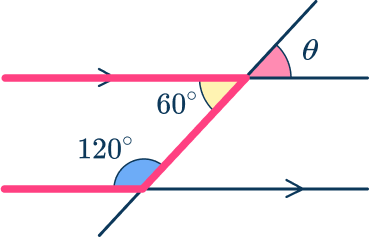
Here, you can label the co-interior angle on the diagram as 60^{\circ} as 120+60=180^{\circ}.
Use basic angle facts if needed to calculate other missing angles.
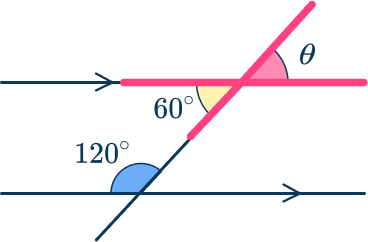
Since \theta and 60^{\circ} are vertically opposite angles, \theta=60^{\circ}.
Example 3: same side interior angles
Calculate the size of the missing angle \theta. Justify your answer.
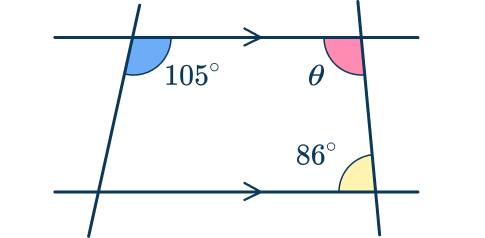
Highlight the angle(s) that you already know.
The given angles are 105^{\circ} and 86^{\circ}.
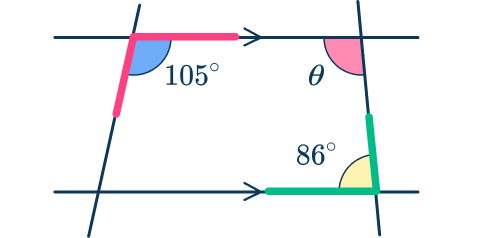
Use same side interior angles to find a missing angle.
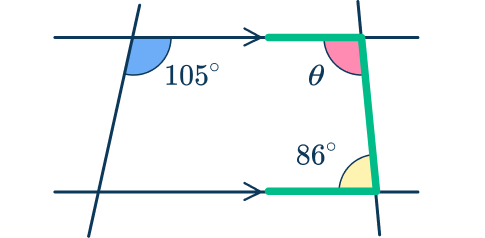
As same side interior angles have a sum of 180^{\circ}, \, 180-86=94 so the missing angle \theta=94^{\circ}.
Example 4: same side interior angles
Calculate the size of the missing angle \theta. Justify your answer.
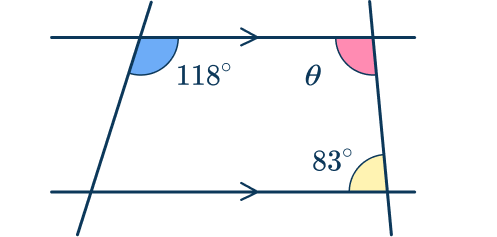
Highlight the angle(s) that you already know.
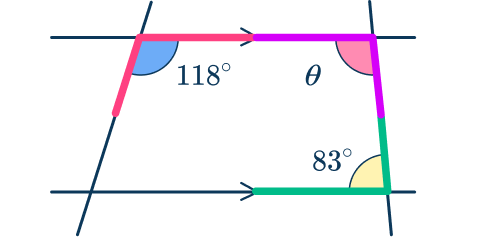
Here, you can use either the 118^{\circ} angle or the 83^{\circ} angle. For this example, we will use the 118^{\circ} angle as this explores an alternative method that we haven’t looked at yet.
Use same side interior angles to find a missing angle.
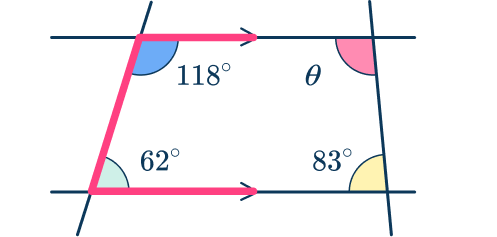
As same side interior angles have a sum of 180^{\circ}, \, 180-118=62^{\circ} so the missing angle highlighted is 62^{\circ}.
Use basic angle facts if needed to calculate other missing angles.
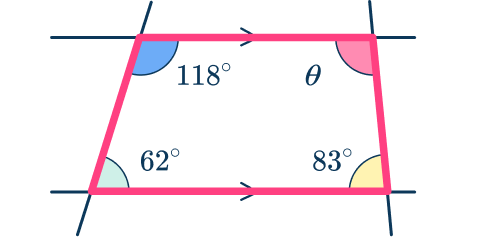
Here you have a trapezoid with the sum of interior angles equal to 360^{\circ}.
Using this fact, you can calculate the value of \theta\text{:}
\begin{aligned}\theta&=360-(118+62+83) \\\\
\theta&=97^{\circ} \end{aligned}
Example 5: same side interior angles with algebra
Find the value of x. Justify your answer.
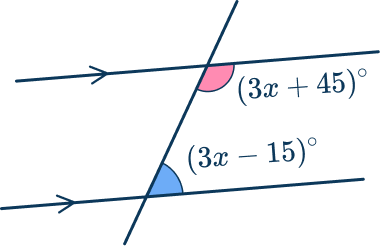
Highlight the angle(s) that you already know.
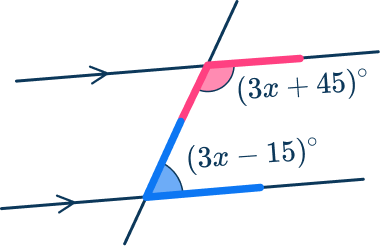
Two angles are labeled but you need to find the value of x.
Use same side interior angles to find a missing angle.
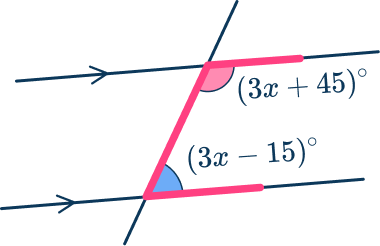
As 3x+45 and 3x-15 are co-interior angles, you can state that
\begin{aligned}& 3 x+45+3 x-15=180 \\\\
& 6 x+30=180 \\\\
& 6 x=150 \\\\
& x=25^{\circ} \end{aligned}
Example 6: same side interior angles with algebra
Calculate the size of the missing angle \theta. Justify your answer.
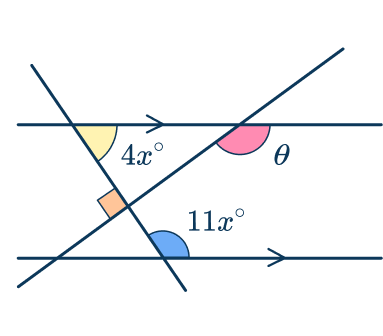
Highlight the angle(s) that you already know.

You need to find the value of x first.
Use same side interior angles to find a missing angle.
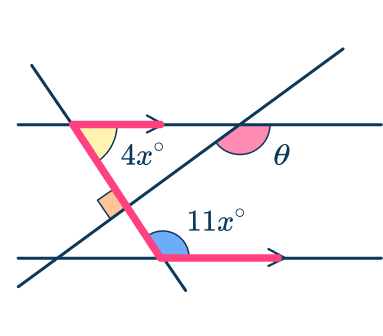
As 11x and 4x are co-interior angles, you can state that
\begin{aligned}11x+4x&=180 \\\\
15x&=180 \\\\
x&=12^{\circ} \end{aligned}
This gives us the two same side interior angles of 11x=132^{\circ} and 4x=48^{\circ}.
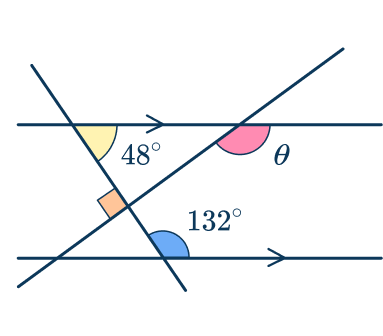
Use basic angle facts if needed to calculate other missing angles.
The angles in the triangle are 48^{\circ} and 90^{\circ}, since the sum of angles on a straight line is 180^{\circ}.
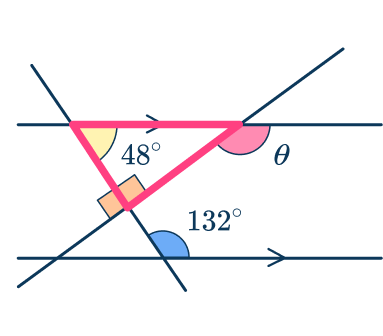
180-(48+90)=42^{\circ} so the third angle in the triangle is 42^{\circ}.
Since \theta and 42^{\circ} are on a straight line,
\begin{aligned}& \theta=180-42 \\\\
& \theta=138^{\circ} \end{aligned}
Teaching tips for same side interior angles
- Begin by reviewing key angle relationships, such as complementary angles, supplementary angles, vertical angles, and adjacent angles. (Review can be given using a study guide or video lesson.) This helps students understand how same side interior angles fit into these broader categories, particularly their supplementary nature when lines are parallel.
- Start with a clear diagram showing two parallel lines cut by a transversal. You can use graph paper to make parallel lines easy to identify. Highlight the same side interior angles with different colors to help students easily identify them.
Easy mistakes to make
- Mixing up angle facts
There are a lot of angle facts and it is easy to mistake alternate angles with corresponding angles. To prevent this from occurring, think about same side interior angles being inside the C shape.
- Using a protractor to measure an angle
Using a protractor to measure an angle. Most diagrams are not to scale and so using a protractor will not result in a correct answer unless it is a coincidence.
- Confusing with polygon angles
Mistaking angles in polygons, like those in a parallelogram, for same side interior angles. Same side interior angles specifically refer to angles formed by a transversal intersecting two lines, not just any interior angles within polygons.
Related parallel angles lessons
Practice same side interior angles questions
1. Calculate the value of \theta.
Justify your answer.
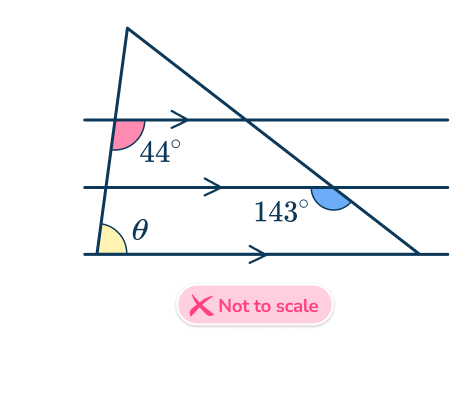




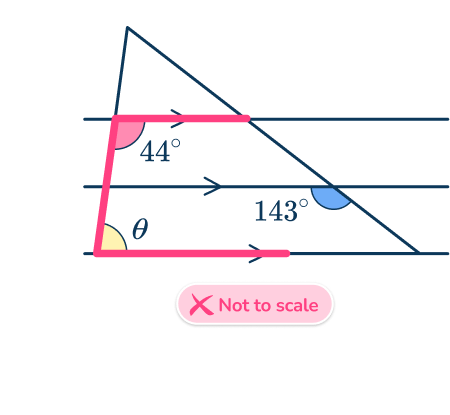
\theta and 44^{\circ} are same side interior angles therefore,
\theta = 180-44=136^{\circ}.
2. Calculate the value of \theta.
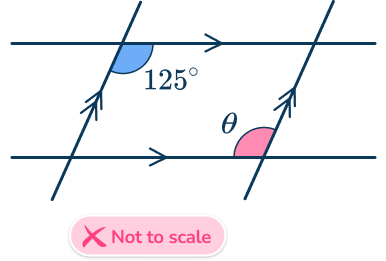




Using same side interior angles, you can calculate 180-125=55^{\circ}.
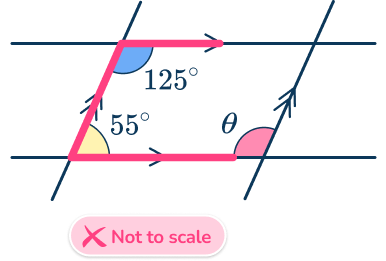
Using same side interior angles again, you can see that \theta=180-55=125^{\circ}.
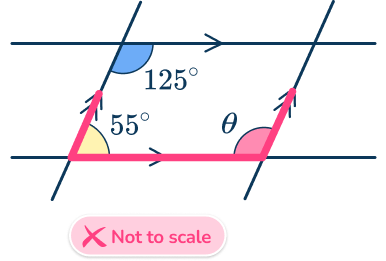
3. Given the information in the diagram, calculate the size of angle \theta.
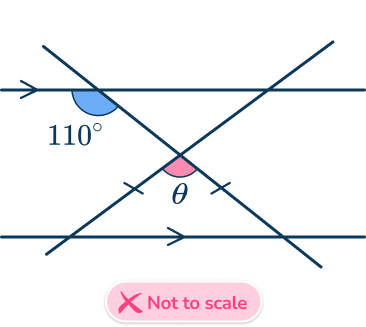




Using same side interior angles, you can calculate 180-110=70^{\circ}.
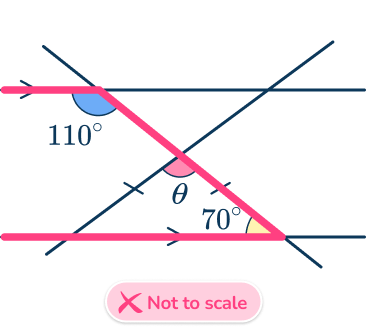
Since it is an isosceles triangle, the other angle at the bottom of the triangle is 70^{\circ} as well.
Then, using angles in a triangle, \theta=180-(70+70)=40^{\circ}.
4. Calculate the value of \theta.
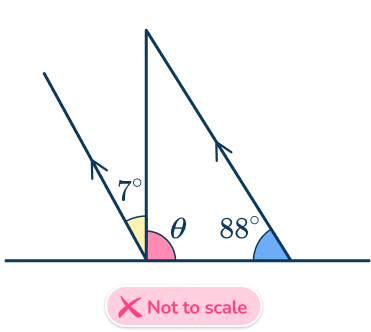




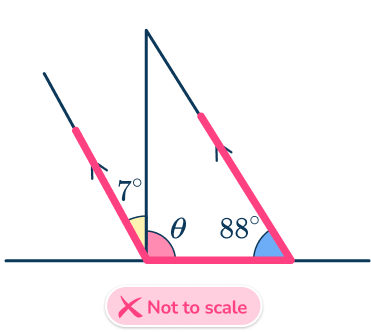
(7+\theta)^{\circ} and 88^{\circ} are same side interior therefore,
\begin{aligned}(7+ \theta) +88&=180 \\\\ \theta&=180-(88+7) \\\\ \theta&=85^{\circ} \end{aligned}
5. Find the value of \theta.
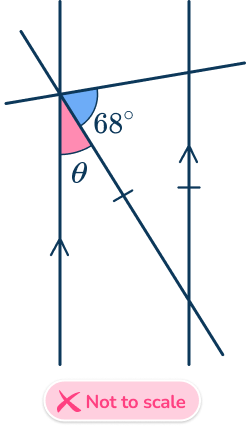




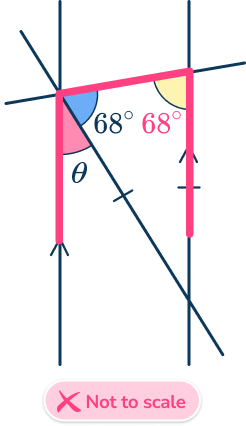
Since the triangle is an isosceles triangle, you know that the other angle at the top of the triangle is 68^{\circ}.
(\theta+68)^{\circ} and 68^{\circ} are same side interior angles therefore,
\begin{aligned}(\theta+68)+68&=180 \\\\ \theta&=180-(68+68) \\\\ \theta&=44^{\circ} \end{aligned}
6. By calculating the value for x, find the size of each angle labeled.
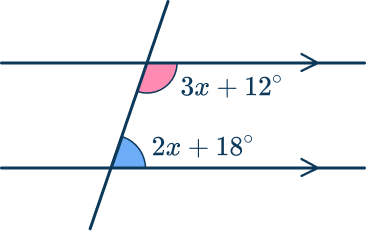
42^{\circ} and 38^{\circ}

30^{\circ} and 38^{\circ}

80^{\circ} and 100^{\circ}

78^{\circ} and 102^{\circ}

3x+12 and 2x+18 are same side interior angles, so they add up to 180^{\circ}. Therefore, you can write
\begin{aligned}3x+12+2x+18&=180 \\\\ 5x+30&=180 \\\\ 5x&=150 \\\\ x&=30 \end{aligned}
x=30 so
\begin{aligned} 3x+12&=3\times30+12=102^{\circ} \\\\ 2x+18&=2 \times 30+18=78^{\circ} \end{aligned}
Same side interior angles FAQs
Same side interior angles are pairs of angles that lie on the same side of a transversal and are located between the two lines that the transversal intersects. These angles are also known as consecutive interior angles.
Same side interior angles are supplementary (their measures add up to 180^{\circ} ) when the two lines intersected by the transversal are parallel. This is a key property used to identify whether two lines are parallel.
Same side interior angles are on the same side of the transversal, whereas alternate interior angles are on opposite sides of the transversal but still between the two intersected lines. Alternate interior angles are congruent when the lines are parallel, while same side interior angles are supplementary.
Same side interior angles are inside the two lines intersected by a transversal, while same side exterior angles are outside the two lines. Both are on the same side of the transversal and are supplementary when the lines are parallel.
The converse states that if a pair of same side interior angles are supplementary, then the lines intersected by the transversal are parallel.
Same side interior angles and linear pairs are both supplementary, adding up to 180^{\circ}, but they differ in position. Linear pairs are adjacent angles formed by intersecting lines, while same side interior angles are non-adjacent angles on the same side of a transversal crossing two lines.
The next lessons are
Still stuck?
At Third Space Learning, we specialize in helping teachers and school leaders to provide personalized math support for more of their students through high-quality, online one-on-one math tutoring delivered by subject experts.
Each week, our tutors support thousands of students who are at risk of not meeting their grade-level expectations, and help accelerate their progress and boost their confidence.

Find out how we can help your students achieve success with our math tutoring programs.
[FREE] Common Core Practice Tests (3rd to 8th Grade)
Prepare for math tests in your state with these 3rd Grade to 8th Grade practice assessments for Common Core and state equivalents.
Get your 6 multiple choice practice tests with detailed answers to support test prep, created by US math teachers for US math teachers!